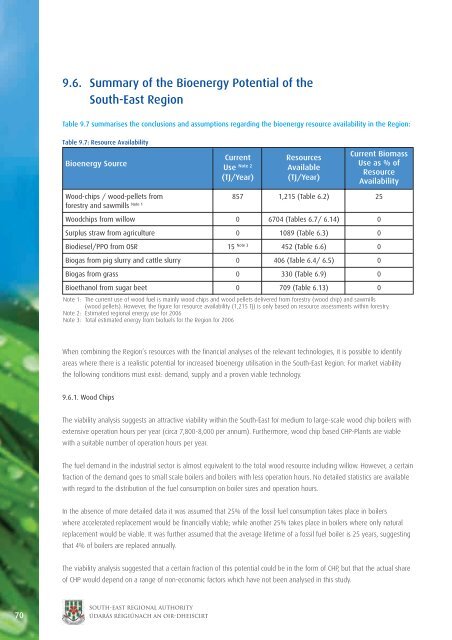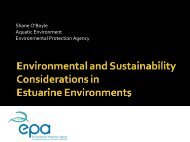Bioenergy Implementation Plan - South-East Regional Authority
Bioenergy Implementation Plan - South-East Regional Authority
Bioenergy Implementation Plan - South-East Regional Authority
Create successful ePaper yourself
Turn your PDF publications into a flip-book with our unique Google optimized e-Paper software.
9.6. Summary of the <strong>Bioenergy</strong> Potential of the<br />
<strong>South</strong>-<strong>East</strong> Region<br />
Table 9.7 summarises the conclusions and assumptions regarding the bioenergy resource availability in the Region:<br />
Table 9.7: Resource Availability<br />
<strong>Bioenergy</strong> Source<br />
Current<br />
Use Note 2<br />
(TJ/Year)<br />
Resources<br />
Available<br />
(TJ/Year)<br />
Current Biomass<br />
Use as % of<br />
Resource<br />
Availability<br />
Wood-chips / wood-pellets from 857 1,215 (Table 6.2) 25<br />
forestry and sawmills Note 1<br />
Woodchips from willow 0 6704 (Tables 6.7/ 6.14) 0<br />
Surplus straw from agriculture 0 1089 (Table 6.3) 0<br />
Biodiesel/PPO from OSR 15 Note 3 452 (Table 6.6) 0<br />
Biogas from pig slurry and cattle slurry 0 406 (Table 6.4/ 6.5) 0<br />
Biogas from grass 0 330 (Table 6.9) 0<br />
Bioethanol from sugar beet 0 709 (Table 6.13) 0<br />
Note 1: The current use of wood fuel is mainly wood chips and wood pellets delivered from forestry (wood chip) and sawmills<br />
(wood pellets). However, the figure for resource availability (1,215 TJ) is only based on resource assessments within forestry.<br />
Note 2: Estimated regional energy use for 2006<br />
Note 3: Total estimated energy from biofuels for the Region for 2006<br />
When combining the Region’s resources with the financial analyses of the relevant technologies, it is possible to identify<br />
areas where there is a realistic potential for increased bioenergy utilisation in the <strong>South</strong>-<strong>East</strong> Region. For market viability<br />
the following conditions must exist: demand, supply and a proven viable technology.<br />
9.6.1. Wood Chips<br />
The viability analysis suggests an attractive viability within the <strong>South</strong>-<strong>East</strong> for medium to large-scale wood chip boilers with<br />
extensive operation hours per year (circa 7,800-8,000 per annum). Furthermore, wood chip based CHP-<strong>Plan</strong>ts are viable<br />
with a suitable number of operation hours per year.<br />
The fuel demand in the industrial sector is almost equivalent to the total wood resource including willow. However, a certain<br />
fraction of the demand goes to small scale boilers and boilers with less operation hours. No detailed statistics are available<br />
with regard to the distribution of the fuel consumption on boiler sizes and operation hours.<br />
In the absence of more detailed data it was assumed that 25% of the fossil fuel consumption takes place in boilers<br />
where accelerated replacement would be financially viable; while another 25% takes place in boilers where only natural<br />
replacement would be viable. It was further assumed that the average lifetime of a fossil fuel boiler is 25 years, suggesting<br />
that 4% of boilers are replaced annually.<br />
The viability analysis suggested that a certain fraction of this potential could be in the form of CHP, but that the actual share<br />
of CHP would depend on a range of non-economic factors which have not been analysed in this study.<br />
70<br />
south-east regional authority<br />
údarás réigiúnach an Oir-DheisCIrt





